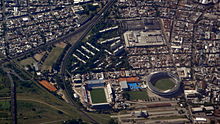Partido Avellaneda
| Avellaneda | |
|---|---|
| Location of Avellaneda in Argentina | |
| Data | |
| Capital | Avellaneda |
| population | 328,900 (2001, INDEC) |
| surface | 54 km² |
| Population density | 5,982 inhabitants / km² |
| Other cities | 9 localidades |
| The Plaza Alsina , in the city center Avellaneda | |
Avellaneda (Argentine pronunciation: [ aβeʒaˈneða ]) is the name of an administrative area (" Partido ") of the Argentine province of Buenos Aires and also the name of its capital. It is part of the metropolitan area of Greater Buenos Aires .
A total of around 330,000 people (2001) live in the 54 km² Partido, the Municipalidad de Avellaneda . In the decade before the last reporting period, the population decreased by almost five percent. The capital Avellaneda is home to around 24,000 people.
In practice, Avellaneda is an industrially oriented suburb in the south of the Argentine capital. Tourists are likely to feel attracted only in rare cases. The part on the Río de la Plata , if accessible at all, is unsuitable for swimming for ecological reasons.
location
Avellaneda is located about five kilometers south of downtown Buenos Aires. The border with the capital district is formed by the extremely polluted Riachuelo River , which forms the border with the La Boca district , which in earlier times was the main port of Buenos Aires. In addition, Avellaneda borders the Río de la Plata in the east, the Partido Quilmes in the south and the Partido Lanús in the west .
Localidades - localities
The Municipalidad de Avellaneda is divided into nine locations, so-called Localidades . Here is a list with the population of 2001:
| Area Reserva Cinturón Ecológico | 3,500 |
| Avellaneda Centro | 24,000 |
| Crucecita | 22,000 |
| Dock south | 36,000 |
| Gerli | 31,000 |
| Piñeyro | 27,000 |
| Sarandí | 61,000 |
| Villa Domínico | 59,000 |
| Savage | 66,000 |
- ↑ The Area Reserva Cinturón Ecológico , the "environmental belt reserve area", is essentially an area around Buenos Aires, in which the waste from the metropolis is deposited and then greened.
economy
Avellaneda is a railway center and one of the most important industrial locations in Argentina. Port facilities for primarily coastal and river shipping, oil refineries, metal processing, textile processing, meat and grain processing , as well as markets for agricultural products in Argentina dominate.
science and education
Avellaneda has two universities: the Universidad Tecnológica Nacional and the Universidad Nacional La Plata-Avellaneda .
history
The original name of Avellaneda was Barracas al Sur - huts in the south. In 1731 the authorities issued an order to build a settlement on the south bank of the Riachuelo River, across from La Boca, the main port of Buenos Aires at the time.
The resulting settlement was renamed in 1904 in honor of the Argentine President Nicolás Avellaneda (term of office: 1874-1880).
Soccer
Avellaneda is home to two of the most important football clubs in the world: CA Independiente and the Racing Club have won the World Cup three times and the Copa Libertadores de América , the South American Cup , eight times .
Independiente plays at the Estadio Libertadores de América , also known as Doble Visera , which has a capacity of around 53,000 spectators. Racing's arena, the Estadio Presidente Perón called El Cilindro , has a capacity of almost 64,000 people. It is only 400 meters from the Independientes Stadium.
In addition to these two clubs, Arsenal de Sarandí is also a frequent participant in the championship competition of the first Argentine soccer league. Club El Porvenir and Sportivo Dock Sud are of local importance and currently (2006) play in the third division.
Hints
Avellaneda is not identical to Parque Avellaneda , which is a quarter ( barrio ) of Buenos Aires .
Town twinning
- Terranova da Sibari , Italy
Personalities
- Mumo Orsi (1901–1986), Argentine-Italian football player
- Adolfo Alfredo Pedernera (1918–1995), Argentine football player and coach
- Juan Carlos Muñoz (1919–2009), football player and coach
- Félix Loustau (1922–2003), Argentine soccer player and coach
- Humberto Maschio (* 1933), Argentinian-Italian soccer player
- Raúl Emilio Bernao (1941-2007), Argentinian football player
- Héctor Yazalde (1946–1997), football player
- Carlos Squeo (1948-2019), football player
- Roberto Acuña (* 1972), Paraguayan football player
- Julio Grondona (1931-2014), Argentine football official
- Carlos Najurieta (* 1924), Argentine racing car driver
Web links
- Statistical information ( Memento of October 8, 2009 in the Internet Archive )
- Community website ( Memento from May 16, 2014 in the Internet Archive )
- La Ciudad - local newspaper ( Memento of October 23, 2008 in the Internet Archive )
- La Ciudad - illustrated history of Avellaneda ( Memento of April 28, 2009 in the Internet Archive )
- Asociación Orígenes de Berazategui - Reseña Histórica de las Comunas Bonaerenses ( Memento of February 1, 2009 in the Internet Archive )
- Ciudad de Wilde - Community website for Localidad Wilde ( Memento from July 24, 2013 in the Internet Archive )
Coordinates: 34 ° 40 ′ S , 58 ° 21 ′ W


